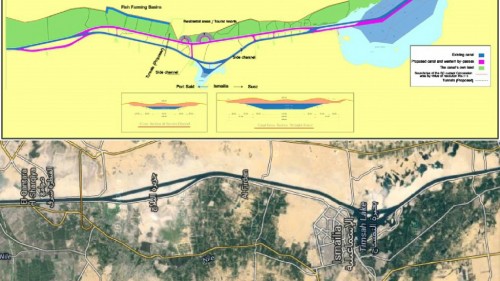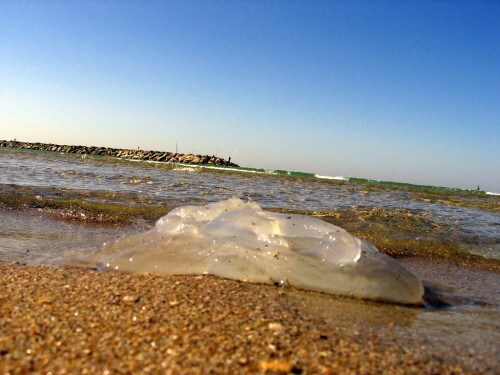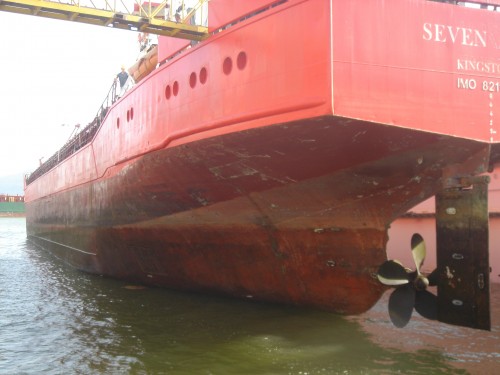While in Tel Aviv anxiously waiting for prolonged works on the light rail, the Egyptians completed in less than a year a huge construction project that was named the new Suez Canal. The problem is that, on the way to restoring Egypt's position in the world, the Egyptians ignored the scientists' pleas to minimize the environmental damage that the new project could cause to the Mediterranean Sea

"A gift to the world from the Egyptian people", proudly proclaims the title Official site of the Suez Canal, the expansion of which was announced by Egyptian President Abdel-Fattah al-Sisi only about a year ago. This week the new Suez Canal was officially opened, which will allow twice the number of ships to pass through one of the most important trade routes in the world, linking East Asia to Europe.
This is the largest excavation project the world has known in recent years, as part of which nearly 250 million cubic meters were excavated. The works included digging a new 32 kilometer long canal parallel to the existing canal, which is 164 kilometers long, and widening and deepening an additional 37 kilometers. The expansion will allow two-way traffic in longer sections of the canal, and will cut the transit time in the canal to half of what exists today. Also, the passage of larger ships will be allowed.
The Suez Canal was dug 146 years ago and passed through several hands until it was nationalized in 1956 by one of the greatest leaders of the Arab world, Egyptian President Gamal Abdel Nasser. Today, the canal expansion project is a lifeline not only for the Egyptian economy that craves foreign currency, but also for the poor national morale, which has been severely damaged as a result of the political and social upheavals that Egypt has known in recent years. In light of all this, criticizing the expansion of the canal is seen as an act of real betrayal, and the struggle of scientists and activists to minimize the environmental damage that is expected to be caused to the Mediterranean Sea seems to be lost in advance.
Go up and thorn it
Experts warn that the expansion of the Suez Canal will increase the passage of maritime invaders to the Mediterranean Sea. These are species of fish and other marine creatures of a tropical nature, which move from the Red Sea and the Indian Ocean through the canal until they reach the Mediterranean Sea. This migration is called "Lespass migration", named after the founder of the (original) Suez Canal, Ferdinand de Lesseps. From the time of its opening in 1869 until today, 350 migratory fish species have been identified in the Mediterranean Sea that migrated through the canal, and are occasionally observed in the waters of the Mediterranean Sea New migrant species.
Maritime experts define the Suez Canal as one of the most significant corridors for the infiltration of maritime invaders. The mass invasion resulted in damage to the local fish population, and the extinction of certain species. The harm is not limited to the impact on one species or another, but rather on the functioning of the delicate ecosystem, which is an important pillar in the lives of the inhabitants of the Mediterranean basin. The proliferation of invasive species reached enormous proportions in some places, since in the new environment there were no competitors and predators that could, naturally, restrain the growth of the population.

The stinging truth
Every summer the jellyfish gets headlines in the newspapers, and the sunbathers on the beach are replaced by creatures with a jelly texture. It's easy to think that jellyfish have always been here, but like other fish species, these are invasive creatures that originate in tropical areas. The common jellyfish on the shores of Israel, known as the wandering cord, migrated here through the Suez Canal decades ago and has thrived ever since. The damage it causes is not limited to unpleasant burns on the skin - the jellyfish harm fishermen and tourists, and endanger electricity generating stations, which pump seawater to cool the facilities and often have to stop pumping to deal with a huge amount of slimy jellyfish that have settled in the cooling system.
The swarms of jellyfish that stretched last July along dozens of kilometers near the coastal strip between Ashkelon and Nahariya are only the first, according to A group of researchers from the Mediterranean basin, including the Israeli representative Dr. Bela Galil from the National Institute of Oceanography, who are very concerned about the negative change that the new Suez Canal may entail. According to these experts, the worse case scenario, which has already begun to materialize, includes an invasion of poisonous fish species such as The long laginun (from the pufferfish family). This fish, which already lives in the waters of the Mediterranean Sea, contains a nerve poison of the tetrodotoxin type, which causes muscle paralysis and even death in some cases. The international group of researchers, which includes 18 experts in the field of marine biology, urged the Egyptian government to conduct an environmental impact assessment before sending the 43 workers to work on the canal mining. The role of the environmental review is to examine what the project's impact will be on the environment, and to present ways to minimize this impact. The group also put pressure on officials in the European Union and the United Nations to call on Egypt to comply with the regulations of the International Convention on Biological Diversity. However, so far the efforts have not borne fruit, and the experts protest the Egyptians' disregard of a lot of information accumulated over many years of research.

A ride on a ship
Dr. Noa Shankar is a marine biologist from the Department of Zoology and the Steinhardt Museum of Nature, Tel Aviv University. In her laboratory, they deal with the documentation of marine invertebrates in the waters of the Mediterranean and conduct surveys near marinas, harbors and vessels to identify invasive species in real time. Shankar emphasizes the essential role of scientists to make their voices heard, even when the Egyptian side is not listening. "As researchers of marine creatures, we know the sensitivity of invasive species and can recommend taking steps to prevent their arrival or reduce the number of individuals in the area after the invasion," she explains.
A study conducted by Shankar and her team in the laboratory showed that the acetylenes are sensitive to water with high salinity. "In the past, the lakes that the Suez Canal crossed had a high salinity, and formed a natural barrier for the passage of species towards the Mediterranean Sea. Over time, dilution of the lake waters with canal water led to a decrease in the salinity level, and as a result, the passage of invaders increased," explains Shankar.
With the expansion of the canal, much larger container ships are expected to pass through it and in greater numbers. Except for raw materials, electrical products and cars, the vessels carry with them hitchhikers of the maritime invaders type, who stick to the vessel and pass all the checkpoints without any problem. The extension of the canal means that a greater number of invasive species will make their way to the Mediterranean. According to Shankar, when an invasive species arrives in a new environment it has no natural predator capable of regulating its culture. "Today, the Mediterranean can be thought of as a person with a weak immune system, which any virus could infect," she says. According to Shankar, the discharge of sewage into the sea and its enrichment with organic matter is one of the factors that allow invasive species to flourish, for example in marinas and harbors.
Apart from the essential steps to preserve the marine environment, Shankar emphasizes the need for the training of experts who will regularly monitor the Mediterranean Sea and who will be able to identify the invasive species at the right time and offer ways to prevent its prosperity. "Unlike land invaders, marine invaders elude us," she says, "and if we don't make an effort to locate them, when we discover them it will be too late."
Impassable air curtain
Solutions to prevent massive migration of invaders through the expanded canal already exist today. One of the more accepted solutions among researchers is the renewal of the natural barrier created in the past by the salty lakes that the canal crosses. Creating a saline buffer can keep out marine invaders that cannot survive in high salinity waters. Other solutions include the transmission of low-frequency sound waves and the creation of an "air screen" - a wall of bubbles, which will prevent marine animals from progressing in the canal.
Either way, on August 6 the film will be released and the opening of the new Suez Canal will be officially announced. It is clear to everyone that what is done cannot be answered; But if the series of steps detailed above are taken, we can hope that future generations will be able to enjoy the Mediterranean that the previous generations enjoyed - rich in local fish and without too many burns.
More of the topic in Hayadan:

4 תגובות
As crazy as it sounds, the level of the Red Sea is 1.5 meters higher than the level of the Mediterranean Sea
(And this is contrary to what we were once taught that sea surfaces are the same in height all over the world)
Therefore the flow there is always from south to north and is quite strong
Why is there migration from the Red Sea to the Mediterranean and not both ways?
How is it that the predators or the factors that limit the number of items from an immigrant species do not go after them?
post Scriptum.
Sewage and garbage discharges add nutrients that allow an outbreak
Invading species ,
As long as the sewage continues to flow into the sea in our country (today sewage flows into the Kishon river)
It's hard to make demands on others...
The channel is indeed narrow for the Mediterranean environment, but it is appropriate to be precise in referring to the environmental dangers,
For example: the elongated laginun does contain a nerve toxin of the tetrodotoxin type,
But unlike the jellyfish (which sting on contact), in order to be harmed by the laginon, you have to eat it.
Egyptian scientists also know all the ways to reduce the number of invaders (not to stop them),
Therefore now that the canal has already been expanded and the ships are moving in it
It is necessary to put pressure on the Egyptians and support them (Mercury),
to realize the same ways: sound waves, bubbles, salt barriers,
At the same time, the Minister of Transportation should stop talking about a "train to Eilat"
as a substitute for the channel "speech that does not add,
The same goes for "Ramon Field" which the Jordanians filed a lawsuit not to operate.
We should remember that neighborly relations are "bilateral",